|
|
|
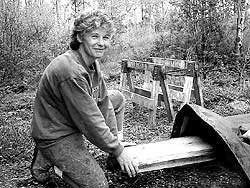 Thelma with wood |
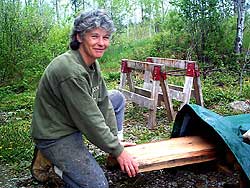 |
|
From Canoes to Chryslers I had to become very familiar with Atikokan's history for my job at the Mining Attraction. Consequently, I found out about Mary Nault's exhaustive compilation of articles called "From Canoes to Chryslers". In two, very large, densely packed binders, Atikokan's history is laid out in chronological order. I found the binders most helpful and borrow the theme for this article from her. Thank you Mary. This past weekend, I traveled my own path from canoes to Chryslers. On Friday afternoon, a grey, drizzly day, I rode out to Fletcher Canoes and spent time with Thelma Cameron, canoe maker. Then, on Saturday afternoon, I walked through time in downtown Atikokan and into the world of antique cars. While the end products were centuries apart, I found an underlying current of passion, commitment and joy with the process of creating. Getting Down to Brass Tacks You feel restful in Thelma Cameron's presence. She has a peace and contentment in her eyes, sky blue and serene, in a tanned face with a ready smile. She is a happy woman; she makes canoes from start to finish for a living. Every morning when she gets up to go to a job, she puts on work clothes and boots and heads out back to the workshops of Fletcher Canoes. Her canoes are custom-ordered, and she makes about ten per year. The workshop smells of urethane, mingled with cedar and sawdust. It is a warm environment that plays with your senses. She is surrounded by the woods she loves to work with, B.C. red cedar. local white cedar, ash, oak, cherry and maple. She creates works of art that are functional too. She took time with me to describe how her canoes are made. The canoe molds, the steaming and bending of the ribs, the thousands of brass tacks holding the planks on, the sanding, the finishing, the painting, even down the caning of the seats – these are the tasks that take up her days. She undertakes them joyously, for the love of the work. Canoes are different from many other consumer items. For the people who buy them, the "story" of the canoe is important. She has been asked, on occasion to photograph the process for the owner. Canoes become part of a family, in many cases passed down through the generations, with their own mythology attached. Thelma likes to know where her canoes are going, and always arranges to meet the owners when they come to pick up their new canoe, so she can see their faces when they see it for the first time. She also sometimes receives letters and photos from owners, letting her know where her canoes have gone. Her family bought the business from her uncle, Paul Fletcher in 1993. Thelma began by helping her son, Michael. Then, about three years ago, she began doing all the jobs and creating the canoes from the lumber up. The canoes are custom-ordered via the Internet (their website is: http://www.fletchercanoes.com ), magazine advertising and the Cameron's participation in trade shows. At a recent show in Wisconsin, they sold three canoes. I feel very fortunate to have been able to visit and learn about canoe construction, from someone who truly loves what she does. It shows in the high quality of the product. ....the Chrysler part.... There is a real irony in having a person who does not drive write about cars. I knew I was in over my head very quickly. I didn't know enough to ask any intelligent questions, so I asked dumb ones. Thankfully, I started with someone I knew, Larry Knowles had been in to the Mining Attraction a number of times, and I felt comfortable talking with him. Then I went on to talk to some of the wives who accompanied their husbands to car shows. What I found out over the course of the afternoon surprised me. I have experience with historical re-enactors from my time with Old Fort William as the librarian there. Re-enactors, like car buffs, travel a circuit, going from Rendezvous to Rendezvous, to camp out in historic canvas tents, where (uncomfortable) historic clothing and forsake all manner of creature comforts, to experience the camaraderie of like-minded souls, and to leave the 20th century behind for a while. I know one woman who hand-sewed a French ball gown, and made her own shoes to go with it. There is passion there. Well, there is passion for old cars too. And as I walked Main Street, it became easy to see why. There was a car, a brown DeSoto that caught my eye. It was the most beautiful, sensual brown – a brown so rich, and so complex that it stopped me in my tracks. The car was shiny, but more than that, it was curvy. You could get lost in its curves. It was a work of art, and it was functional too. This is not a car that gets trailered around. It drives, and I am sure it does so very smoothly. Like canoes, these cars provide an outlet for a passion. "Story" is as important to the men and women who work on these cars, as it is to canoe owners. I saw scrap books with photos of the restoration process, from the frame up. It would be an injustice to call this a "hobby", that name can not describe depth of emotion, the commitment to "getting it right" that I saw. In both cases, from canoes to Chryslers, these are works of functional art. And we are drawn to them for that. They provide a doorway out of our mundane daily life where form follows function and the things we use are no longer ornate, but sleek, streamlined, for the pace of the new millenium. Does anyone remember how beautiful old cash registers used to be? And ornate cornices on buildings. We don't have those things anymore, but we do have canoes, and, because of a different passion, we have lovely old Chryslers, DeSotos, Studebakers and Fords, in rainbows of intense, wonderful colours. |
|
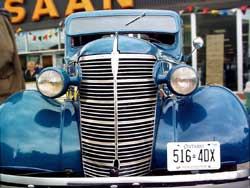 Blue grill: a bug's eye view |
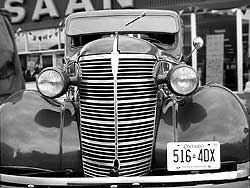 |
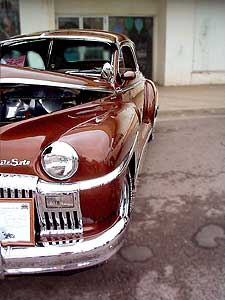 The DeSoto |
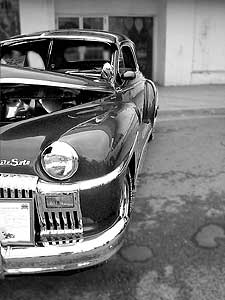
|